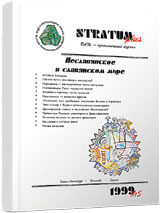Торговый инвентарь женских погребений эпохи викингов (субъективная интерпретация)
Trade Utensils of Female Burials of the Viking Age. (Subjective Interpretation)
Author(s): Anne StalsbergSubject(s): History, Anthropology, Social Sciences, Archaeology, Social history, Gender history, Middle Ages, Cultural Anthropology / Ethnology, 6th to 12th Centuries
Published by: Издательский дом Stratum, Университет «Высшая антропологическая школа»
Summary/Abstract: The article is dedicated to the social interpretation of female burials of the Viking Age that contained trade utensils. We are talking about folding scales of bronze and small weights of bronze or iron covered by bronze, of various forms. They are dated by the late IX-XI c. It is widely known that the scales and weights are directly connected with trading, even though their usage is possible for other purposes. Trade inventory is usually regarded as belonging to a male tradesman. The presence of such kind of inventory in female burials is usually either not explained or is not discussed as an attribute of trading. The interpretations that can be encountered in the scientific literature regard trade utensils in female burials as anomaly that demands a special interpretation. The author of the article believes that the housewife is buried together with the trade utensils belonging to her family on which she had the same right as her husband, replacing him or, maybe, being his widow. In such case trade utensils in the burial are a sign of the profession of the family, not of a certain person. On the basis of the analysis of archaeological data and written records the author suggests that women could play the role of tradesmen at the Viking Age in their society.
Journal: Stratum plus. Археология и культурная антропология
- Issue Year: 1999
- Issue No: 5
- Page Range: 158-163
- Page Count: 6
- Language: Russian

